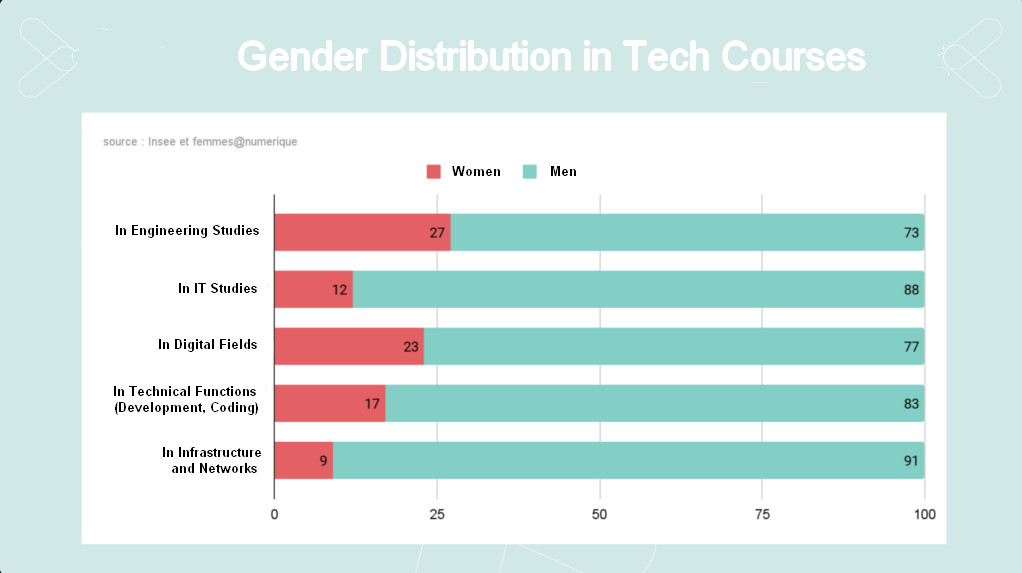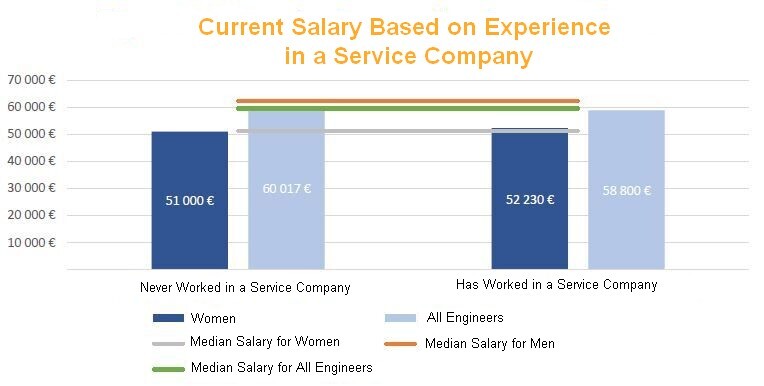Code au féminin: Gender equality, key to innovation in IT development

Published on: 26 July 2024 - Updated on: 6 August 2024 - Read 565 times - Reading time: 9 minutes
It is not us, business application developers, who are going to say the opposite, technology shapes our daily lives and our future and the IT development sector is at the heart of innovation. We try to show it through our various articles.
Yet there is a shadow over this seemingly bright picture: the glaring gender imbalance. Gender equality in technology, and more specifically in software development, is not just a matter of social justice; it is a crucial issue for the future of our digital society .
Imagine a world where the applications, software, and systems we use every day are built by truly diverse teams, reflecting the richness and variety of their users. This vision is not just desirable, it is necessary. Gender equality in software development is not just about numbers or quotas to hit. It is about unlocking untapped potential for ideas, perspectives, and innovations that could revolutionize the way we interact with technology .
In this article, we explore the challenges of gender equality in the software development industry, the obstacles that persist, and the promising solutions that are emerging. Because if code is the language of the future, it is time for all voices to be heard in this new lingua franca of the 21st century.
State of play: The reality of the figures
Despite the progress made in recent years, the software development sector remains marked by a persistent gender imbalance. The numbers speak for themselves and paint a picture that calls for action.
Representation of women in IT development

According to the latest studies, women represent only about 20% of software development professionals worldwide. This figure varies by country, but remains low overall. In the United States, for example, only 18% of computer science graduates are women, a percentage that has paradoxically decreased since the 1980s, when it was 37%.
In Europe, the situation is not much better. In the European Union, women represent only 17% of ICT (Information and Communication Technologies) specialists, a figure that has stagnated for several years.
Pay gaps and career progression
Beyond underrepresentation, inequalities also manifest themselves in compensation and career opportunities. According to various studies, women in the technology sector earn on average 20 to 25% less than their male counterparts for equivalent positions.
 The salary gap between men and women engineers has increased to 21.7%, according to the Observatory of Women Engineers 2023. However, working or having worked in an ESN improves women's salaries.
The salary gap between men and women engineers has increased to 21.7%, according to the Observatory of Women Engineers 2023. However, working or having worked in an ESN improves women's salaries.
Source: Observatory of Women Engineers 2023
Career progression also presents notable disparities. Women are underrepresented in technical leadership roles, holding less than 10% of senior leadership positions at tech companies. This “pipeline leak” becomes more pronounced as you move up the ladder, with only 5% of CEO positions at tech companies held by women.
These alarming figures are not only a reflection of social injustice, they also represent a waste of talent and potential for the industry . They highlight the urgency of concrete actions to promote gender equality in IT development, not only for ethical reasons, but also to boost innovation and competitiveness in the sector.
Gender Equality Issues in IT Development
 Gender equality in IT development is crucial to the future of the industry and society, driving innovation, improving product quality, filling talent gaps and inspiring future generations.
Gender equality in IT development is crucial to the future of the industry and society, driving innovation, improving product quality, filling talent gaps and inspiring future generations.
Gender equality in software development is not just a matter of social justice, it is a crucial issue for the future of the sector and society as a whole . The implications of this equality are multiple and profound, affecting innovation, product quality and economic performance.
Innovation, the engine of technological progress, thrives on diverse perspectives. When development teams include diverse backgrounds, they naturally generate more innovative ideas. Women, with their unique experiences, provide creative solutions to complex problems. It’s no coincidence that companies with greater gender diversity often outperform their competitors in terms of financial performance and innovation.
As a design office specializing in the development of business applications , we know that designing inclusive products is another fundamental aspect. The technologies we use daily must meet the needs of all users, regardless of their gender. However, development teams that are predominantly male risk introducing unconscious biases into the design . We remember the first voice recognition systems that struggled to identify female voices, simply because they had been mainly developed and tested by men. A balanced representation of genders in teams helps to avoid these pitfalls and create products that are truly suitable for everyone. As such, two-fifths of our employees are women .
The tech sector is facing a growing shortage of skilled talent . Encouraging more women to join software development is not just a matter of equity, it is an economic necessity. By fully harnessing the potential of half the population, the industry can close this skills gap and drive growth. It is an untapped talent pool that could revolutionize the sector.
Business performance also benefits from this diversity. Mixed teams demonstrate greater creativity and perform better in solving complex problems. This diversity, when extended to management positions, often translates into better financial performance for companies.
Finally, increasing the visibility of women in software development has a crucial impact on future generations. By providing inspiring role models to young girls, we create a virtuous circle that will encourage more women to enter this exciting field. This is how, gradually, gender equality in the sector will strengthen, bringing with it a wave of innovation and progress.
Gender equality in IT development is therefore not a luxury, but a necessity. It is the key to a more innovative, more inclusive and more efficient technological future, capable of meeting the complex challenges of our time.
Obstacles to gender equality
Despite the clear benefits of gender equality in software development, many barriers persist, hindering progress in this field. These barriers, often subtle but deeply rooted, require careful attention to be overcome.
Stereotypes and unconscious biases remain among the most persistent obstacles. From a young age, girls are often discouraged, sometimes unconsciously, from taking an interest in scientific and technological fields. The image of the developer, often represented as an asocial man working alone in front of his screen, does not correspond to the diverse reality of the profession and can dissuade many talented women from engaging in it. These stereotypes unfortunately persist even in the professional world, where women's skills in IT are sometimes questioned, creating an unwelcoming environment.
The lack of female role models in the industry compounds this problem. Girls and women have few examples of success to look up to in the software development field. The industry’s iconic figures, celebrated in the media and schools, are overwhelmingly male. This lack of representation can lead women to doubt their legitimacy in the field or not consider a career in development as a viable option.
Tech workplace culture also poses a major challenge. Often described as “bro culture,” it can be unwelcoming to women. Male-dominated work environments can unintentionally exclude women from informal networks that are crucial for career advancement. Hiring and promotion practices can also be tainted by unconscious bias, favoring male candidates over equally qualified female candidates.
The phenomenon of the “ leaky pipeline ” makes matters worse. Even when women enter the software development sector, they are more likely than their male counterparts to leave the profession mid-career. The reasons are many: lack of support, difficulties balancing work and personal life, feelings of isolation or career stagnation . This loss of experienced female talent perpetuates the gender imbalance in leadership positions and deprives the sector of valuable skills.
Finally, harassment and discrimination, while less common than they once were, remain realities in some work environments. These toxic behaviors, whether blatant or subtle, create a hostile climate that pushes many talented women out of the industry or never into it.
These barriers, while significant, are not insurmountable. Recognizing them is the first step toward lasting change. By clearly identifying them, we can begin to develop effective strategies to overcome them, paving the way for a more balanced, innovative, and inclusive software development industry.
Solutions et initiatives
 Various initiatives aim to overcome gender inequality in IT development, creating a more balanced and innovative technology ecosystem.
Various initiatives aim to overcome gender inequality in IT development, creating a more balanced and innovative technology ecosystem.
Faced with the persistent challenges of gender inequality in IT development, many solutions and initiatives are emerging, offering promising avenues for sustainable change. These varied and complementary approaches tackle the roots of the problem while proposing concrete actions to promote inclusion.
Education and awareness-raising from an early age play a crucial role. Innovative programmes in primary and secondary schools aim to spark girls’ interest in computer science and programming. These initiatives, such as girls-only coding clubs or mixed-sex robotics workshops, demystify technology and show girls that they have a place in this field. At the same time, awareness campaigns target parents and teachers, encouraging them to actively support girls’ technological aspirations.
Mentorship and support programs are proving particularly effective in retaining women in the industry. By connecting experienced professionals with newcomers or students, these programs provide valuable support, practical advice, and a vital professional network. Organizations like Women Who Code and Girls Who Code play a major role in this area, creating communities of support and mutual aid that extend well beyond the professional sphere.
Corporate policies that promote diversity and inclusion are gaining traction. More tech companies are implementing diversity goals , reviewing their hiring processes to eliminate bias, and offering inclusion training to all employees. Some are going further by introducing return-to-work programs for women who have taken a career break, or offering flexible schedules and equitable parental leave to help with work-life balance.
Initiatives to raise visibility and recognition for women in the sector are multiplying . Conferences dedicated to women in tech, awards rewarding female excellence in IT development, and media campaigns highlighting inspiring female role models are helping to change perceptions and inspire the next generation.
Institutional and government support also plays an important role. Public policies encouraging gender equality in STEM (Science, Technology, Engineering and Mathematics), targeted funding for research on diversity in tech, or tax incentives for companies actively promoting gender equality, are all powerful levers to accelerate change.
Finally, involving men in this equality process is crucial. Awareness and alliance programs, encouraging men to become active advocates for gender equality in their professional environment, are starting to bear fruit. This inclusive approach recognizes that gender equality is beneficial for all and requires the commitment of the entire tech community.
These solutions and initiatives, while diverse, share a common goal: to create an ecosystem where women can thrive in software development. Their success is based on a holistic approach, combining education, professional support, cultural change, and institutional commitment. While the road to equality is still long, these initiatives are paving the way for a more balanced and innovative future in the world of technology.
The challenge of the digital century: transforming promises into reality
 Gender equality in IT is crucial to fully exploit the innovative potential of society.
Gender equality in IT is crucial to fully exploit the innovative potential of society.
Gender equality in IT development is not just an ideal to be achieved, but an imperative necessity for the future of the technology sector and our digital society. At the end of this analysis, it is clear that the challenges are numerous, but the opportunities and potential benefits are immense.
The road to equality is paved with stubborn obstacles: persistent stereotypes, a lack of female role models, and uninclusive corporate cultures. Yet each of these challenges also represents an opportunity for transformation. By tackling these issues, the software development industry is not only correcting an injustice, it is giving itself the means to fully exploit the creative and innovative potential of the entire population.
Emerging initiatives and solutions offer hope. From early education to progressive corporate policies, mentoring programs and institutional support, every action contributes to shaping a more equitable environment. These efforts should not be seen as concessions, but as investments in the future of the sector.
The challenge goes far beyond the technology industry. In a world where digital technology permeates every aspect of our lives, diversity among the creators of these technologies is crucial. It ensures that the solutions developed meet the needs of all, without bias or blind spots.
Change won’t happen overnight, but every step counts. Businesses, educational institutions, governments and individuals all have a role to play. It’s time to move from awareness to concrete action, to transform good intentions into daily practices.
Gender equality in software development is not just a matter of social justice, it is a business imperative and a catalyst for innovation . By fully embracing this diversity, the industry is empowered to address the complex challenges of our time and create a truly inclusive and innovative technological future .
Tomorrow's code will be written by diverse hands, carrying a richer and more complete vision of the world. It is up to all of us, stakeholders in the sector and society, to ensure that this vision becomes reality.
The content of this article is based on our own research. However, you can also look at the references below to refine your thinking.
-
Women in computing on Wikipedia : Women have played an important role in the development of computing. They have shaped the evolution of information technology. They were the first female programmers in the early 20th century and have made major contributions to the industry.
-
Coding the Future: Women Shaking Up the Tech Industry on the creative-tim.com website : Explore the transformative impact of women in technology as they shape the future, challenge stereotypes, and drive innovation.
-
Tech: Where are the women? Figures on the shopopop.com website : Discover the feminine world of Tech through figures, clearly showing their presence in this world that is not just masculine!
-
Women in Web Development on ironhack.com : Why is web development such a male dominated field? Are there any women in web development? Let's take a look.
-
Cracking the Code: Innovation for a gender equal future on the site relx.com : How we're embracing equity in tech across RELX.
Article updated on August 6, 2024
If you enjoyed this article, you're sure to enjoy this selection!


